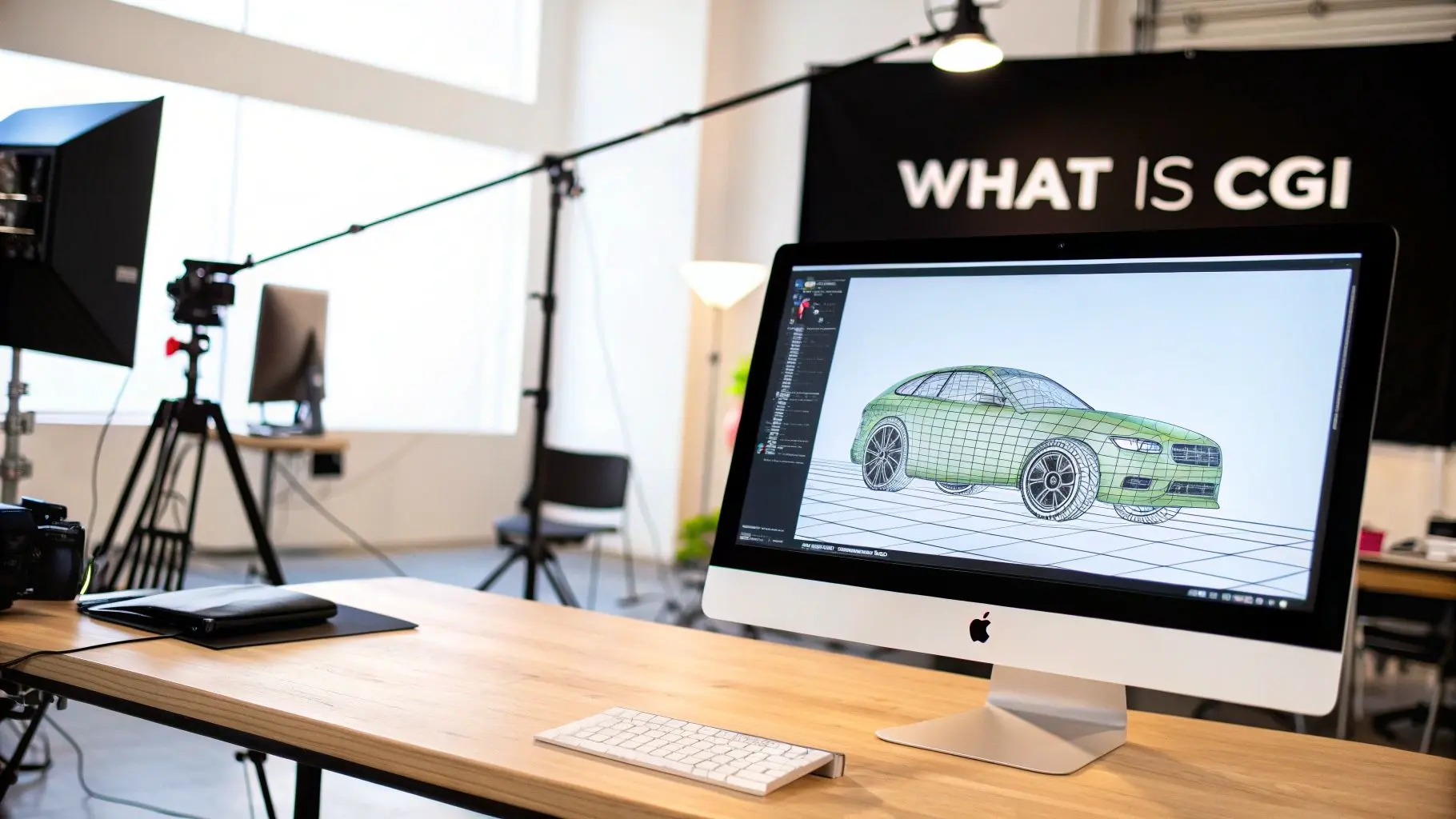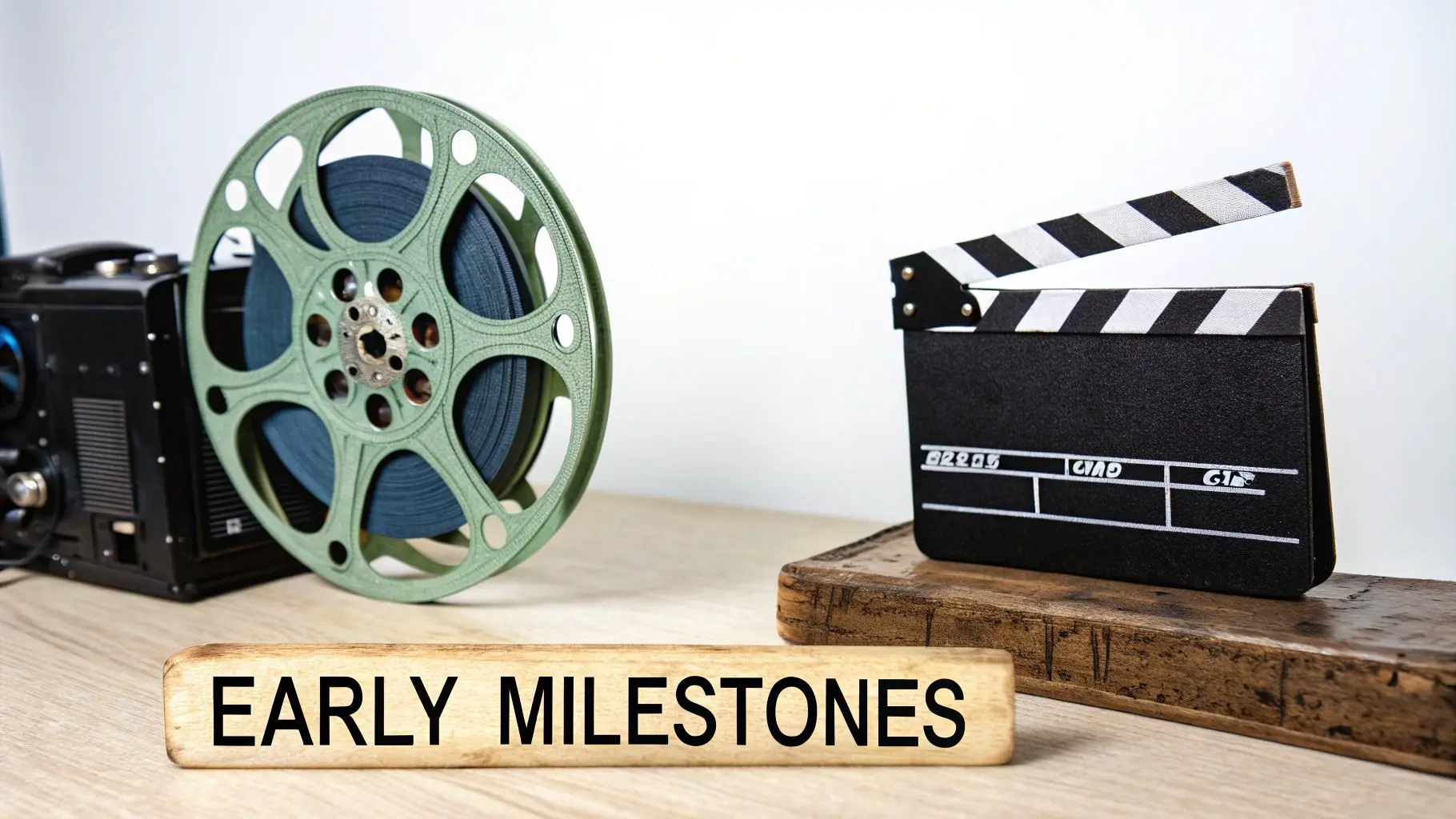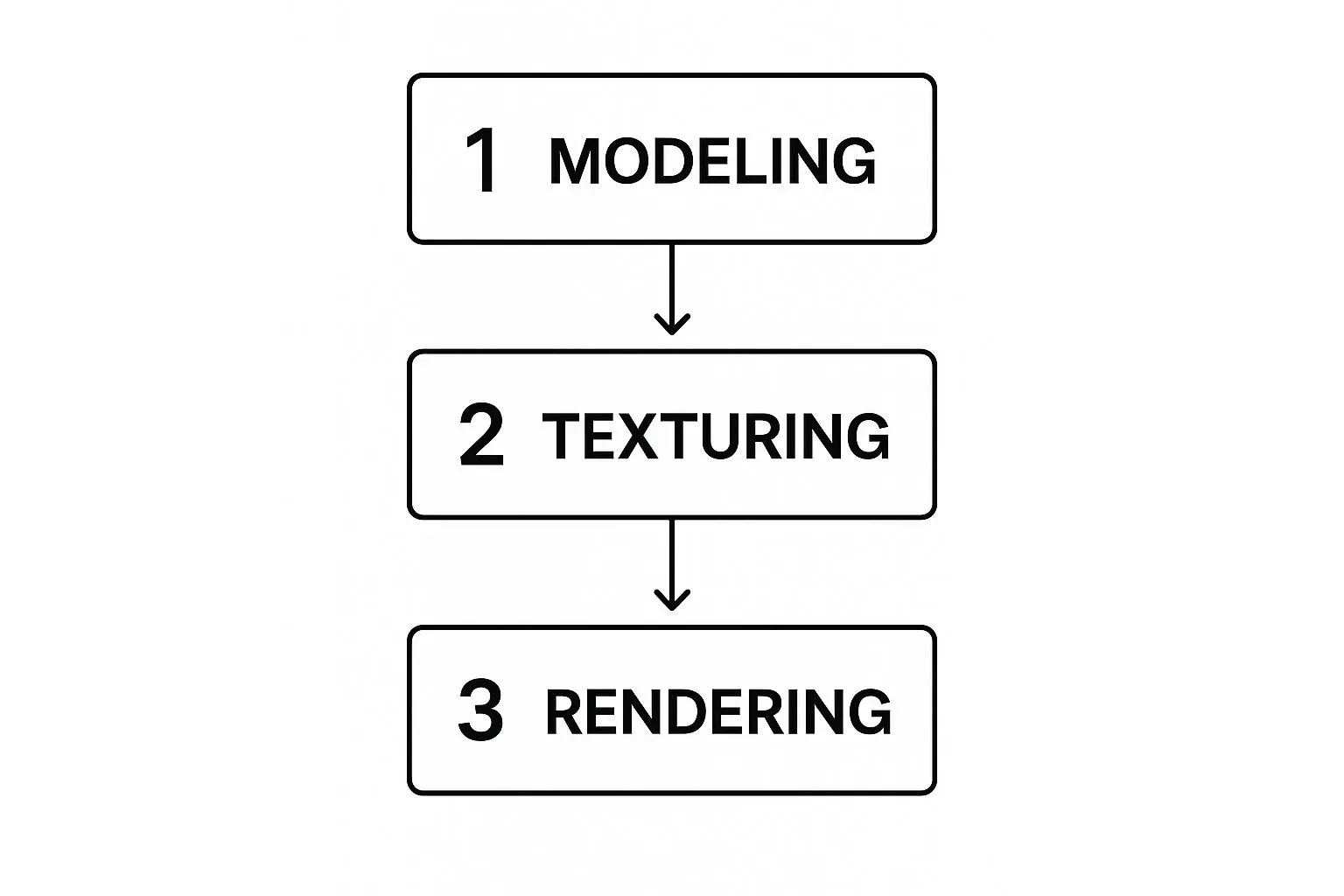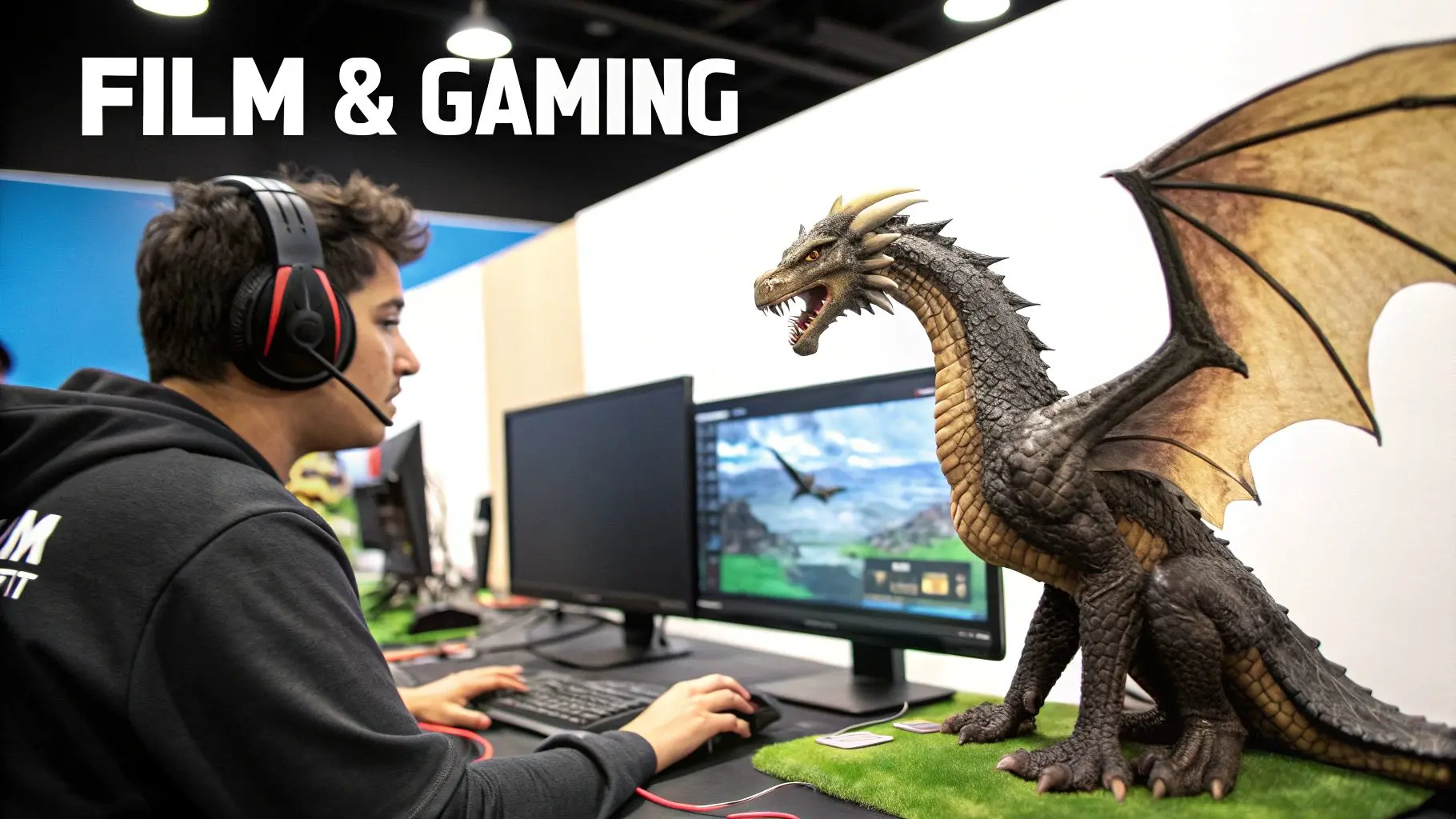What is CGI Animation? A Complete Guide to Digital Creation
At its heart, CGI (Computer-Generated Imagery) animation is the art of bringing images to life using computers. Instead of drawing on paper or moving physical models, artists build, rig, and move characters and objects inside a virtual space. Think of it less like traditional cartooning and more like sophisticated digital puppetry, used to create everything from animated TV series to jaw-dropping visual effects. This digital approach allows for a level of detail, realism, and creative freedom that would be wildly impractical, if not impossible, to achieve by hand. It has become the engine of modern visual storytelling, driving blockbuster films, immersive video games, and the slick product visuals you see in adverts every day.
Getting to Grips with CGI Fundamentals

While traditional animation is built on thousands of physical drawings or stop-motion models, CGI is born and lives entirely inside a computer. Its digital DNA is what unlocks a breathtaking level of detail and opens up a universe of creative possibilities. It has truly become the engine of modern visual storytelling, driving everything from the alien worlds in blockbuster films to the slick product visuals you see in adverts every single day.
The Two Flavours of CGI
The world of CGI animation really branches into two main paths, each with its own toolkit and best-use cases.
- •2D CGI Animation: This involves creating and moving digital artwork on a flat, two-dimensional plane (think x and y axes). It’s like a high-tech version of paper cut-out animation. Characters and scenery are created as flat images and then brought to life in software. It’s the go-to style for many explainer videos, mobile games, and TV shows.
- •3D CGI Animation: This is what most people imagine when they hear "CGI". Here, artists construct models that have depth, volume, and texture within a three-dimensional digital world (using x, y, and z axes). This approach makes it possible to play with realistic lighting, shadows, and camera movements, giving everything a tangible sense of weight and presence. If you're curious about what goes into this, you can dive into the magic of 3D animation.
The fundamental difference really boils down to one word: depth. 2D CGI is about clever layering of flat images, whereas 3D CGI is about building entire digital worlds. You even have virtual cameras that can swoop and glide through the scene, just like in a live-action film. This distinction shapes the entire production process, from the first sketch to the final render.
CGI Animation at a Glance
To quickly see how CGI stacks up against traditional methods, here’s a simple breakdown.
| Aspect | CGI Animation | Traditional Animation |
|---|---|---|
| Medium | Entirely digital, created with software. | Physical media like paper, cels, or clay. |
| Creation Process | Building digital models and "rigging" them for movement. | Drawing thousands of individual frames by hand. |
| Flexibility | Easy to edit, duplicate, and reuse assets. Changes are less time-intensive. | Very labour-intensive to make changes; requires re-drawing frames. |
| Realism | Can achieve photorealistic lighting, textures, and physics. | Style is typically more stylised and illustrative. |
| Dimension | Works in both 2D (flat planes) and 3D (virtual worlds with depth). | Primarily 2D, with stop-motion being the physical 3D equivalent. |
This table highlights the core shift in thinking and technique. CGI isn't just a new tool; it's a completely different way of bringing imagination to the screen.
The Evolution of CGI from Lab to Blockbuster

The seamless digital worlds we see on screen today are the result of a long, fascinating journey. CGI animation didn't just spring to life in Hollywood studios; its roots trace back to the academic and scientific labs of the 1960s and 70s. Back then, it was a tool for visualising complex data and molecular structures. These early experiments laid the essential groundwork. By the early 1970s, computer-assisted animation was emerging, helping to automate repetitive tasks. Innovators in the UK were particularly influential, using early CGI to create educational films explaining challenging subjects like quantum physics. You can dive deeper into these pioneering computer animation efforts from the UK.
From Wireframes to Lifelike Characters
The 1980s marked a turning point, as CGI stepped into mainstream entertainment. Films like Tron (1982) and The Last Starfighter (1984) offered a glimpse of what was possible, creating digital environments and futuristic vehicles that captured the public's imagination. But it was the 1990s that truly cemented CGI’s place in cinema. This was the decade where technology and artistic ambition grew explosively, giving us unforgettable, game-changing moments.
- •Terminator 2: Judgment Day (1991): The liquid-metal T-1000 was a watershed moment, proving CGI could create fluid, morphing shapes that were terrifyingly convincing.
- •Jurassic Park (1993): This film masterfully blended practical effects with CGI to bring dinosaurs roaring back to life with breathtaking realism, setting a new benchmark for visual effects.
- •Toy Story (1995): As the first fully computer-animated feature film, Toy Story was revolutionary. It showed the world that CGI could carry an entire story with genuine emotional depth, not just serve as a flashy special effect.
These breakthroughs didn't just create eye candy; they reshaped the economics of filmmaking.
The Impact on Production
Before CGI, complex visual effects relied on intricate miniatures, matte paintings, and painstaking optical compositing. These methods were time-consuming and unforgiving; a mistake could mean starting an entire shot from scratch.
CGI introduced a level of flexibility that was previously unimaginable. Digital assets could be tweaked, duplicated, and reused with relative ease. This ability to iterate and refine dramatically reduced the cost and time involved in ambitious visual storytelling, opening up a universe of creative possibilities that were simply out of reach before.
This evolution, from a niche scientific tool to a mainstream entertainment powerhouse, was driven by decades of tireless innovation. It has fundamentally transformed how we tell stories, enabling creators to build worlds limited only by their imagination.
How CGI Animation Is Made Step by Step
Understanding how CGI animation is made is less like watching an artist draw and more like observing a high-tech assembly line. Each stage is a distinct craft, blending meticulous technical skill with creative vision. To really understand what CGI animation is, we need to walk through this process. It all begins with a solid plan.
Pre-Production: The Creative Blueprint
This is where the foundation of the story is laid. Everything that follows hinges on the clarity and creativity established here.
- Concept and Storyboarding: Every project starts with an idea. Artists create concept art to define the look and feel of the characters and their world. The script is then turned into a storyboard, a comic book version of the film that maps out every shot, camera angle, and key action.
- Animatics: The storyboard is then given a rough animation treatment called an "animatic." Panels are timed with basic sound and dialogue, giving the team their first feel for the film's pacing. It’s a vital step for catching story problems early, saving significant time and money later.
Production: Building the Digital World
This is where concepts become tangible digital assets. It’s a massive team effort, bringing together specialists with diverse skills. This flow, from sculpting a raw model to giving it a detailed, believable surface, is at the heart of bringing any CGI asset to life.
This flow, from sculpting a raw model to giving it a detailed, believable surface, is at the heart of bringing any CGI asset to life. - •3D Modelling: Think of this as digital sculpting. Using software like Blender or Autodesk Maya, artists build characters, props, and environments from a 3D mesh made of polygons.
- •Texturing: A new 3D model is a grey, featureless sculpture. Texturing is the art of painting it, applying colour, patterns, and surface details that define whether something looks like rough wood, gleaming metal, or soft fabric.
- •Rigging: For a character to move, it needs a skeleton. Rigging is the technical process of building this internal digital skeleton and control system, giving animators the controls to pose the limbs, face, and body.
- •Animation: With a rigged character ready, animators breathe life into it. They move the character frame by frame, crafting a performance that conveys weight, emotion, and personality.
Post-Production: The Final Polish
Once all scenes are animated, the final steps blend all elements together for the screen.
- •Lighting: Just like on a real film set, digital lights are placed in the 3D scene to create mood, atmosphere, and realism. Lighting is crucial for guiding the viewer's eye and making the digital world feel tangible.
- •Rendering: This is the most computer-intensive part of the process. The software takes all the data, models, textures, lighting, animation, and calculates the final, high-quality image for each frame. A single frame can take minutes or even hours to render.
- •Compositing: Finally, all the rendered layers (characters, backgrounds, special effects) are combined into the final shot. This is also where colour correction and other visual tweaks are made to ensure everything looks seamless and polished.
Exploring Modern CGI Animation Techniques

Once a digital model is built, textured, and rigged, the animator's performance begins. Bringing a character to life isn’t a one-size-fits-all job; it involves a toolbox of specialised methods, each suited to different creative goals. Understanding these core techniques reveals the true artistry behind believable on-screen motion. These methods are the invisible engines driving everything from the fluid movements of a superhero to the chaotic tumble of debris in an explosion.
Keyframe Animation: The Animator’s Craft
Keyframe animation is the digital evolution of traditional hand-drawn techniques. It’s a meticulous, artist-driven process where an animator sets crucial poses, or keyframes, at specific points in time to define the start and end of a movement. For example, to make a character wave, the animator sets a keyframe with the hand down, another with the hand raised, and a final one with the hand back down. The computer then smoothly fills in the "in-between" frames. This method gives the animator complete creative control over every detail of the performance, from the subtle timing of a facial expression to the arc of a character leaping through the air.
Motion Capture: Capturing Human Nuance
When hyper-realism is the goal, animators often turn to Motion Capture (or "mocap"). This technique records the movements of a real actor and translates that performance data directly onto a digital character. Actors wear special suits with sensors, and their performance is captured by specialised cameras. This data creates a rich, authentic foundation for the animation, preserving the subtle nuances and mannerisms of a genuine human performance.
Mocap is fantastic for capturing complex, full-body movements that would be incredibly time-consuming to create convincingly with keyframes. It's the technology behind the lifelike performances in many modern video games and VFX-heavy films.
Procedural Animation and Simulation
Not all animation is performed by hand. Procedural animation uses algorithms and rule-based systems to generate motion automatically. This is the perfect tool for creating complex, large-scale phenomena that would be impossible to animate manually. Animators set the initial conditions and physical rules, and the software simulates the outcome. This approach is essential for:
- •Physics-based simulations: Creating realistic fire, smoke, water, and explosions.
- •Crowd generation: Simulating the behaviour of thousands of individuals in a battle scene or a bustling city.
- •Dynamic effects: Animating flowing cloth, wind-blown hair, or a collapsing building.
This technique blends creativity and computation, allowing artists to direct natural forces. Game engines are particularly adept at handling these simulations in real-time, a topic we explore in our overview of Unreal Engine 5 for virtual reality. Together, these methods, from the hands-on control of keyframing to the automated power of simulation, form the core of modern what is CGI animation workflows.
Where You See CGI Animation in Everyday Life
When you hear "CGI", it's easy to picture alien worlds or monsters in the latest blockbuster. But its influence reaches far beyond cinema. CGI animation is a flexible tool woven into the media we consume daily, often in ways you might not realise. From adverts to mobile games, CGI is constantly working behind the scenes. Its ability to create impossible visuals and simplify complex ideas makes it a go-to solution for a huge range of industries.
Entertainment Beyond the Big Screen
The most obvious places you’ll spot CGI outside of film are in television and video games. Entire animated series, especially for children, are now built from the ground up using CGI, allowing creators to build vibrant, consistent worlds efficiently across multiple episodes. The UK, in particular, is a global powerhouse in this space, with hubs in cities like London, Bristol, and Manchester creating franchises loved worldwide. Think of shows like Peppa Pig, which has captured global audiences in around 180 countries. You can learn more about the UK's globally recognised animation sector and its impact. Video games are another world where CGI is fundamental. Unlike pre-rendered animation in films, games rely on real-time CGI. This means your console or PC generates the graphics on the fly, responding instantly to your every move. It’s this technology that makes immersive, interactive worlds possible.
CGI in gaming isn't just about making things look good; it's about building a responsive, dynamic environment that reacts to the player. Every character model, environment, and visual effect is a CGI asset designed for immediate interaction.
Professional and Commercial Applications
Outside of entertainment, CGI is an essential tool for businesses to communicate and visualise ideas. Its applications are both practical and creative, solving problems that traditional media cannot. Here are just a few key examples:
- •Advertising: Brands use CGI to create flawless product visuals. Whether it’s a car gliding through an impossible landscape or a photorealistic shot of a new smartphone, CGI delivers perfect imagery that would be difficult or expensive to capture with a real camera.
- •Architectural Visualisation: Architects and developers use CGI to create realistic "fly-throughs" of new buildings, giving stakeholders a clear vision of the finished project long before construction begins.
- •Medical and Training Simulations: In high-stakes fields like surgery or aviation, CGI is used to build safe, repeatable training environments, allowing professionals to practise complex procedures without real-world risk.
- •Corporate Explainer Videos: Have a complex service or new software to explain? CGI animation is the perfect tool to break it down, turning abstract concepts into simple, digestible visuals.
Why Businesses are Betting Big on CGI Animation
Beyond the glitz of film and TV, CGI animation offers serious, real-world advantages for businesses in every sector. In a commercial sense, what is CGI? It’s a powerful communication tool that can deliver a significant return on investment. One of its biggest benefits is making complicated things simple. If your company deals in technical products or intricate services, animation can break down intimidating concepts into clear, engaging visuals. This helps customers ‘get it’ instantly, shortening the sales cycle.
Unlocking Creative and Financial Wins
CGI also provides the creative freedom to visualise anything you can imagine, enabling brands to create visuals that would be expensive, dangerous, or impossible to film. Think about showing the inner workings of machinery or bringing a global data network to life, CGI makes it happen without logistical headaches. From a marketing perspective, the advantages are clear:
- •Sky-High Engagement: Animated content is naturally more dynamic and eye-catching, proven to hold attention longer on websites and social media.
- •Better Information Recall: People are far more likely to remember a message when it’s presented in an engaging animated story compared to static text or images.
- •Higher Conversion Rates: A well-made explainer video on a landing page can directly boost conversion rates by making a product’s benefits obvious and compelling.
This reliance on animation isn’t just anecdotal. The global animation industry was valued at a massive £259 billion in 2022 and is forecast to hit £375 billion by 2027. This boom is happening here in the UK, too, as companies use CGI for everything from corporate communications to staff training, reporting big jumps in viewer engagement. You can dive deeper into the impact of animation on audiences to see the data for yourself. Professional animation services are not just a creative indulgence. They're a strategic investment that builds brand clarity, engages audiences, and drives measurable business results. Now, let's clear up a few common questions that always seem to pop up when we talk about CGI.
What Is the Difference Between CGI and Animation?
Think of animation as the broad art form of making things move. CGI is one of the tools in the animator's toolbox to achieve that. So, while all CGI is a type of animation, not all animation is CGI. Classic hand-drawn cartoons or stop-motion films are beautiful forms of animation that don't rely on computer generation.
Is CGI Cheaper Than Live-Action Filming?
This is a classic "how long is a piece of string?" question. The answer depends entirely on the project's scope. A straightforward animated explainer video will likely be more budget-friendly than a full-scale live-action commercial with actors, locations, and set building. However, a photorealistic CGI blockbuster can cost hundreds of millions, far more than most live-action films, due to the immense expert human hours required.
How Long Does It Take to Create CGI Animation?
Again, it all comes down to the scale and level of detail. A snappy 30-second motion graphics piece for social media might be turned around in a couple of weeks. But for high-end character animation for a TV show, a single minute of footage can easily take a team of artists several months to complete, moving through every stage of the production pipeline we've discussed. At Studio Liddell, we've been helping brands and creators navigate these production realities since 1996, delivering world-class CGI that gets results. Ready to see what your vision could look like in motion? Have a look through our work at https://studioliddell.com and book a production scoping call with our team. Article created using Outrank